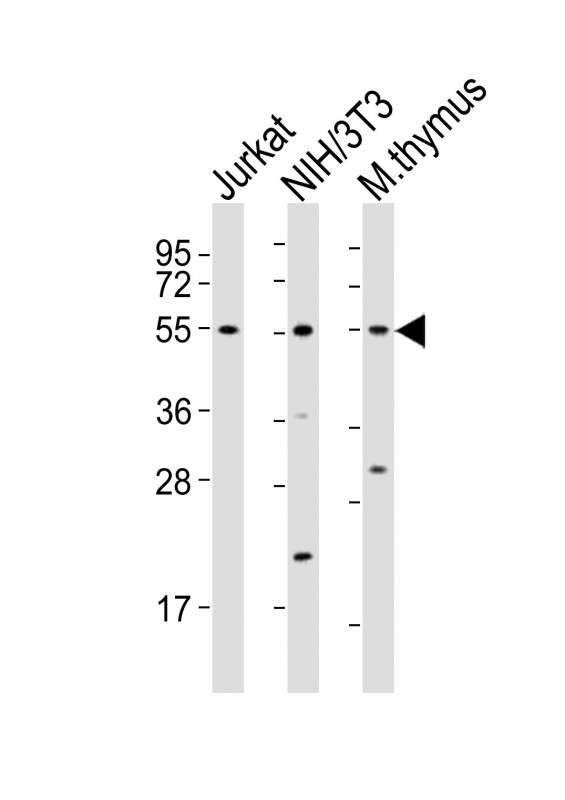
| WB | 1/2000 | Human,Mouse,Rat |
| IF | 咨询技术 | Human,Mouse,Rat |
| IHC | 咨询技术 | Human,Mouse,Rat |
| ICC | 技术咨询 | Human,Mouse,Rat |
| FCM | 咨询技术 | Human,Mouse,Rat |
| Elisa | 咨询技术 | Human,Mouse,Rat |
| Aliases | Runt-related transcription factor 1, Acute myeloid leukemia 1 protein, Core-binding factor subunit alpha-2, CBF-alpha-2, Oncogene AML-1, Polyomavirus enhancer-binding protein 2 alpha B subunit, PEA2-alpha B, PEBP2-alpha B, SL3-3 enhancer factor 1 alpha B subunit, SL3/AKV core-binding factor alpha B subunit, Runx1, Aml1, Cbfa2, Pebp2ab |
| WB Predicted band size | 48.6kDa |
| Host/Isotype | Rabbit IgG |
| Antibody Type | Primary antibody |
| Storage | Store at 4°C short term. Aliquot and store at -20°C long term. Avoid freeze/thaw cycles. |
| Species Reactivity | Human, Mouse, Rat |
| Immunogen | This Mouse Runx1 antibody is generated from a rabbit immunized with a KLH conjugated synthetic peptide between 426-459 amino acids from the C-terminal region of Mouse Runx1. |
+ +
以下是3篇涉及Mouse Runx1抗体的代表性文献(文献标题、作者及摘要内容概览):
---
1. **文献名称**: *Runx1 is required for the endothelial to hematopoietic cell transition during embryogenesis*
**作者**: Yokomizo T, et al.
**摘要**: 该研究利用Runx1抗体通过免疫组化和流式细胞术,证明Runx1在胚胎期内皮细胞向造血干细胞分化中的关键作用,抗体特异性验证显示其在小鼠主动脉-性腺-中肾区(AGM)的表达模式。
2. **文献名称**: *A Runx1-Smad6 rheostat controls Runx1 activity in hematopoietic specification*
**作者**: Pimanda JE, et al.
**摘要**: 研究通过Western blot和ChIP实验(使用抗Runx1抗体),揭示了Runx1与Smad6的相互作用调控造血祖细胞分化的分子机制,证实小鼠模型中Runx1活性梯度决定细胞命运。
3. **文献名称**: *Single-cell analysis of Runx1 haploinsufficiency in mouse hematopoietic development*
**作者**: Chen MJ, et al.
**摘要**: 结合单细胞RNA测序和Runx1抗体标记的流式分选,探讨Runx1单倍剂量不足对小鼠造血干细胞异质性的影响,发现其导致早期造血细胞分化阻滞。
---
**备注**:上述文献均聚焦Runx1在小鼠造血系统中的作用,抗体应用场景包括蛋白定位(免疫组化)、表达定量(Western blot)及细胞分选(流式)。建议通过PubMed或Google Scholar输入关键词“Runx1 antibody mouse”进一步筛选具体实验方法学文献。
The Mouse Runx1 antibody is a crucial tool in molecular and cellular biology research, specifically targeting the Runt-related transcription factor 1 (Runx1), also known as AML1 or CBFA2. Runx1 plays a pivotal role in hematopoiesis, regulating the differentiation of hematopoietic stem cells and the development of blood lineages. It is also implicated in skeletal development, neurogenesis, and cancer pathogenesis, particularly in leukemias where chromosomal translocations involving Runx1 are common.
This antibody, typically raised in mouse hosts, is designed to detect endogenous Runx1 protein in various experimental applications, including Western blotting, immunohistochemistry (IHC), immunofluorescence (IF), and flow cytometry. It is often validated for specificity using knockout cell lines or tissues to ensure minimal cross-reactivity. Researchers employ it to study Runx1's expression patterns during embryonic development, its regulatory mechanisms in gene transcription, and its dysfunction in diseases like acute myeloid leukemia (AML).
Commercial Runx1 antibodies are frequently characterized for reactivity across species, such as human, mouse, and rat, enabling cross-species comparative studies. Their utility extends to both basic research and clinical investigations, aiding in biomarker discovery and therapeutic target validation. Proper validation and optimization for each application are critical to ensure reliable results, given Runx1's variable expression levels across tissues and cell types.
×